Financial Audit Analysis: Medibank Private Ltd's Annual Report Review
VerifiedAdded on 2023/02/01
|12
|2529
|22
Report
AI Summary
This report provides a comprehensive audit analysis of Medibank Private Ltd, focusing on its financial statements. It begins by explaining the concept of materiality and its application in auditing, particularly in the context of Medibank's financial reporting. The report then examines the notes and disclosures within Medibank's annual reports, highlighting key areas like deferred acquisition costs and contingent liabilities. Analytical procedures, including ratio analysis (current, quick, net profit margin, etc.), are applied to assess the company's liquidity and profitability. A detailed analysis of the cash flow statement, outlining cash inflows and outflows from operations, investment, and financing activities, is also included. The report concludes with an analysis of the auditor's report, assessing the audit opinion and the company's adherence to accounting standards, ultimately providing an overview of Medibank's financial performance and position, based on the audit perspective. The report is a student submission to Desklib.
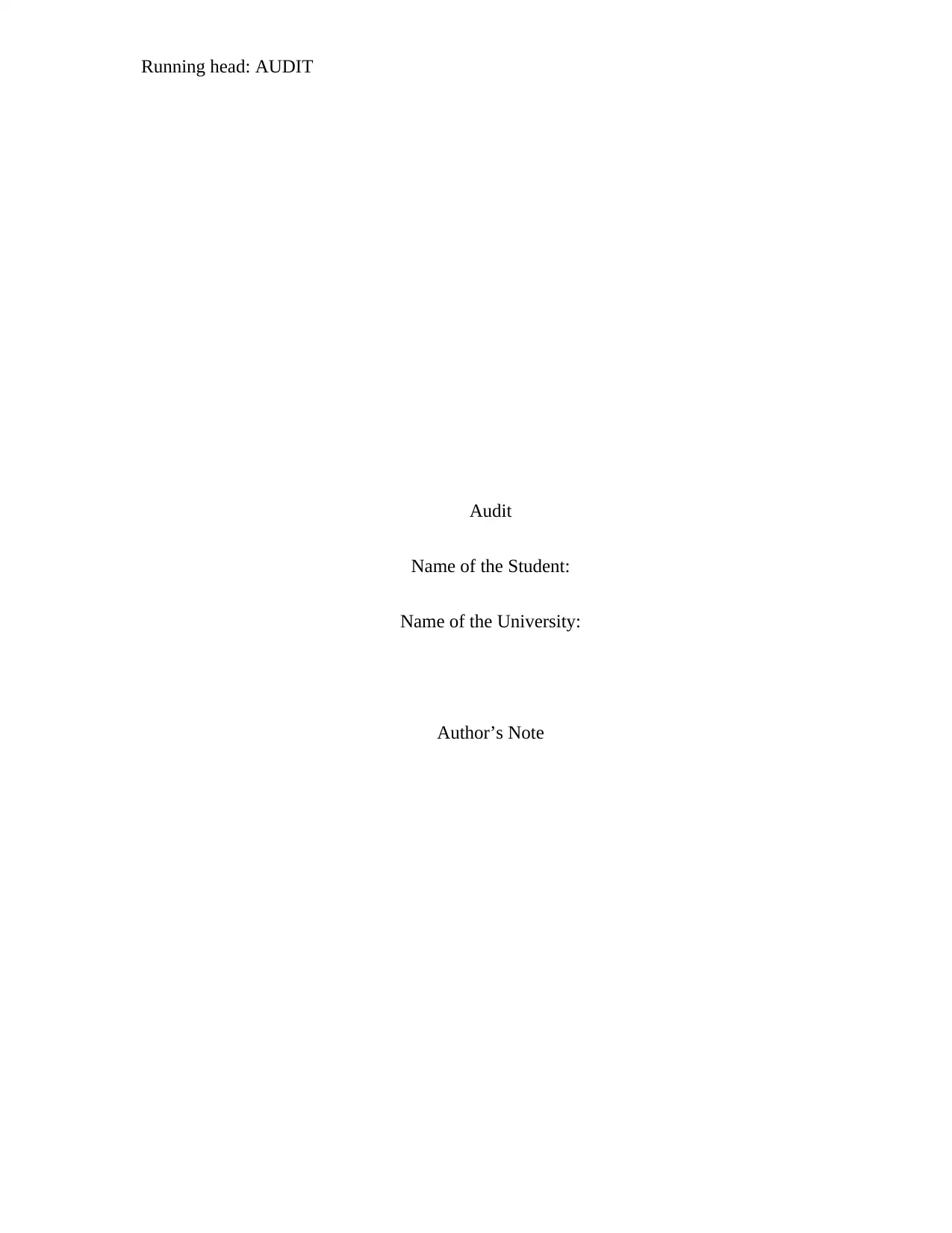
Running head: AUDIT
Audit
Name of the Student:
Name of the University:
Author’s Note
Audit
Name of the Student:
Name of the University:
Author’s Note
Paraphrase This Document
Need a fresh take? Get an instant paraphrase of this document with our AI Paraphraser
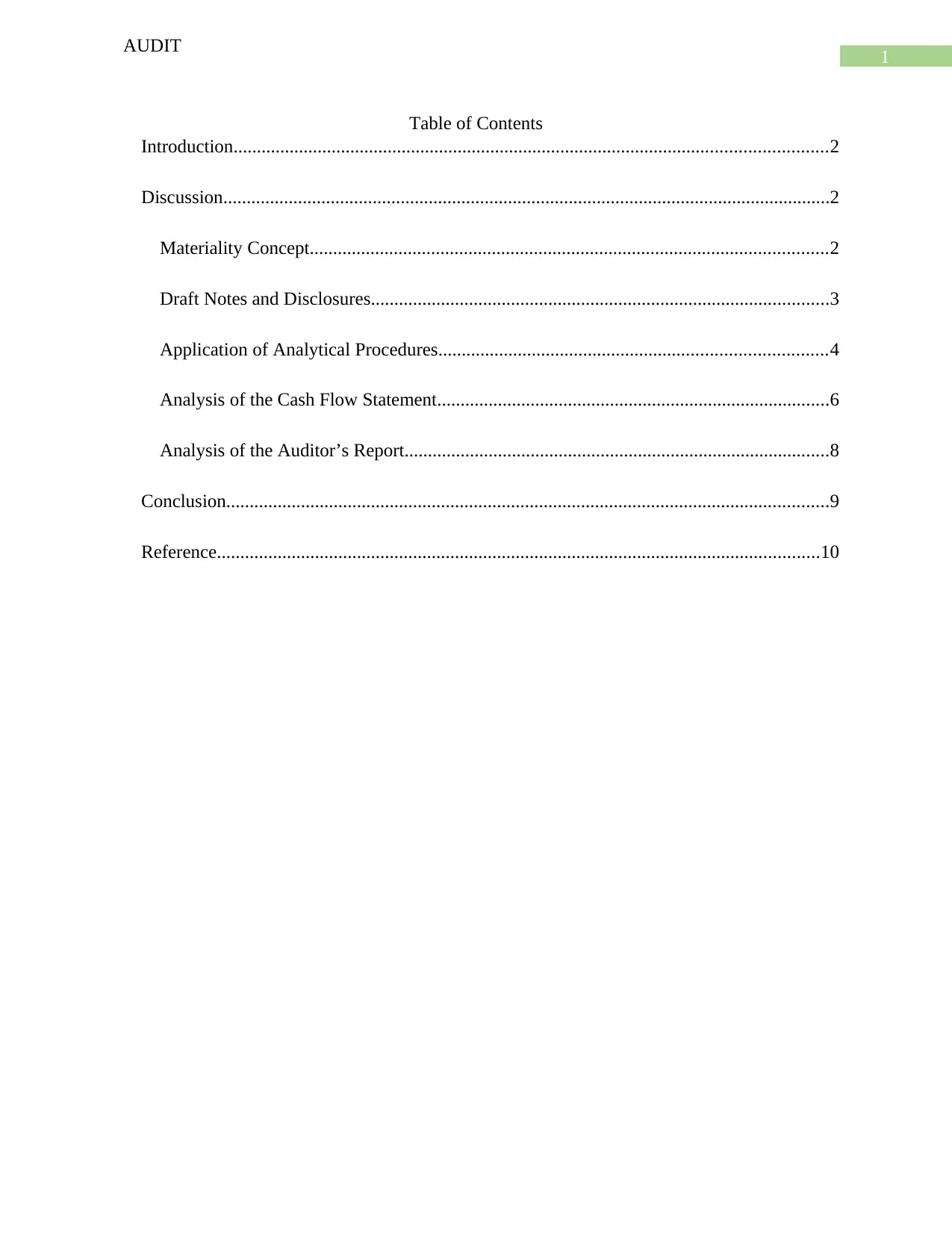
1
AUDIT
Table of Contents
Introduction...............................................................................................................................2
Discussion..................................................................................................................................2
Materiality Concept...............................................................................................................2
Draft Notes and Disclosures..................................................................................................3
Application of Analytical Procedures...................................................................................4
Analysis of the Cash Flow Statement....................................................................................6
Analysis of the Auditor’s Report...........................................................................................8
Conclusion.................................................................................................................................9
Reference.................................................................................................................................10
AUDIT
Table of Contents
Introduction...............................................................................................................................2
Discussion..................................................................................................................................2
Materiality Concept...............................................................................................................2
Draft Notes and Disclosures..................................................................................................3
Application of Analytical Procedures...................................................................................4
Analysis of the Cash Flow Statement....................................................................................6
Analysis of the Auditor’s Report...........................................................................................8
Conclusion.................................................................................................................................9
Reference.................................................................................................................................10
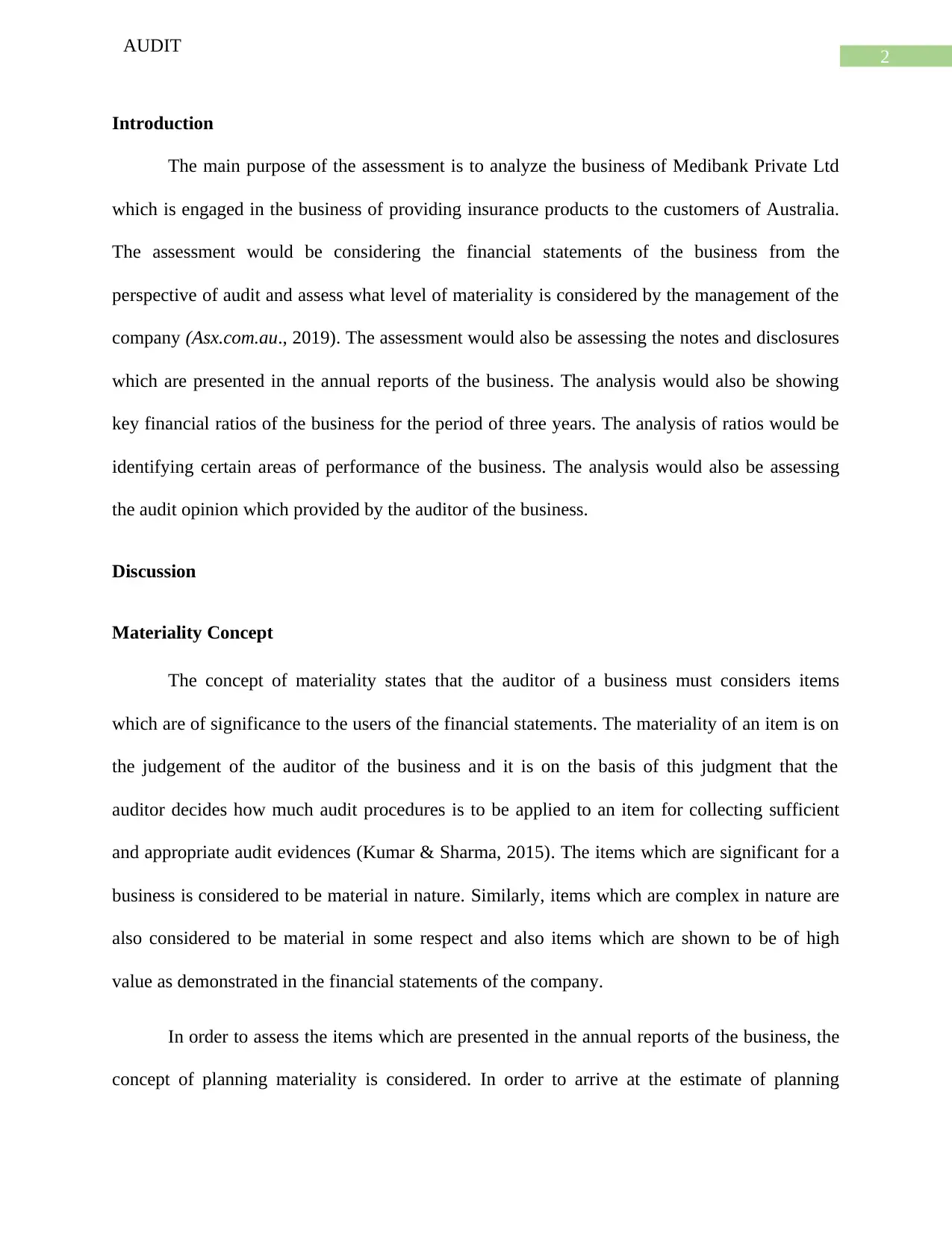
2
AUDIT
Introduction
The main purpose of the assessment is to analyze the business of Medibank Private Ltd
which is engaged in the business of providing insurance products to the customers of Australia.
The assessment would be considering the financial statements of the business from the
perspective of audit and assess what level of materiality is considered by the management of the
company (Asx.com.au., 2019). The assessment would also be assessing the notes and disclosures
which are presented in the annual reports of the business. The analysis would also be showing
key financial ratios of the business for the period of three years. The analysis of ratios would be
identifying certain areas of performance of the business. The analysis would also be assessing
the audit opinion which provided by the auditor of the business.
Discussion
Materiality Concept
The concept of materiality states that the auditor of a business must considers items
which are of significance to the users of the financial statements. The materiality of an item is on
the judgement of the auditor of the business and it is on the basis of this judgment that the
auditor decides how much audit procedures is to be applied to an item for collecting sufficient
and appropriate audit evidences (Kumar & Sharma, 2015). The items which are significant for a
business is considered to be material in nature. Similarly, items which are complex in nature are
also considered to be material in some respect and also items which are shown to be of high
value as demonstrated in the financial statements of the company.
In order to assess the items which are presented in the annual reports of the business, the
concept of planning materiality is considered. In order to arrive at the estimate of planning
AUDIT
Introduction
The main purpose of the assessment is to analyze the business of Medibank Private Ltd
which is engaged in the business of providing insurance products to the customers of Australia.
The assessment would be considering the financial statements of the business from the
perspective of audit and assess what level of materiality is considered by the management of the
company (Asx.com.au., 2019). The assessment would also be assessing the notes and disclosures
which are presented in the annual reports of the business. The analysis would also be showing
key financial ratios of the business for the period of three years. The analysis of ratios would be
identifying certain areas of performance of the business. The analysis would also be assessing
the audit opinion which provided by the auditor of the business.
Discussion
Materiality Concept
The concept of materiality states that the auditor of a business must considers items
which are of significance to the users of the financial statements. The materiality of an item is on
the judgement of the auditor of the business and it is on the basis of this judgment that the
auditor decides how much audit procedures is to be applied to an item for collecting sufficient
and appropriate audit evidences (Kumar & Sharma, 2015). The items which are significant for a
business is considered to be material in nature. Similarly, items which are complex in nature are
also considered to be material in some respect and also items which are shown to be of high
value as demonstrated in the financial statements of the company.
In order to assess the items which are presented in the annual reports of the business, the
concept of planning materiality is considered. In order to arrive at the estimate of planning
⊘ This is a preview!⊘
Do you want full access?
Subscribe today to unlock all pages.

Trusted by 1+ million students worldwide
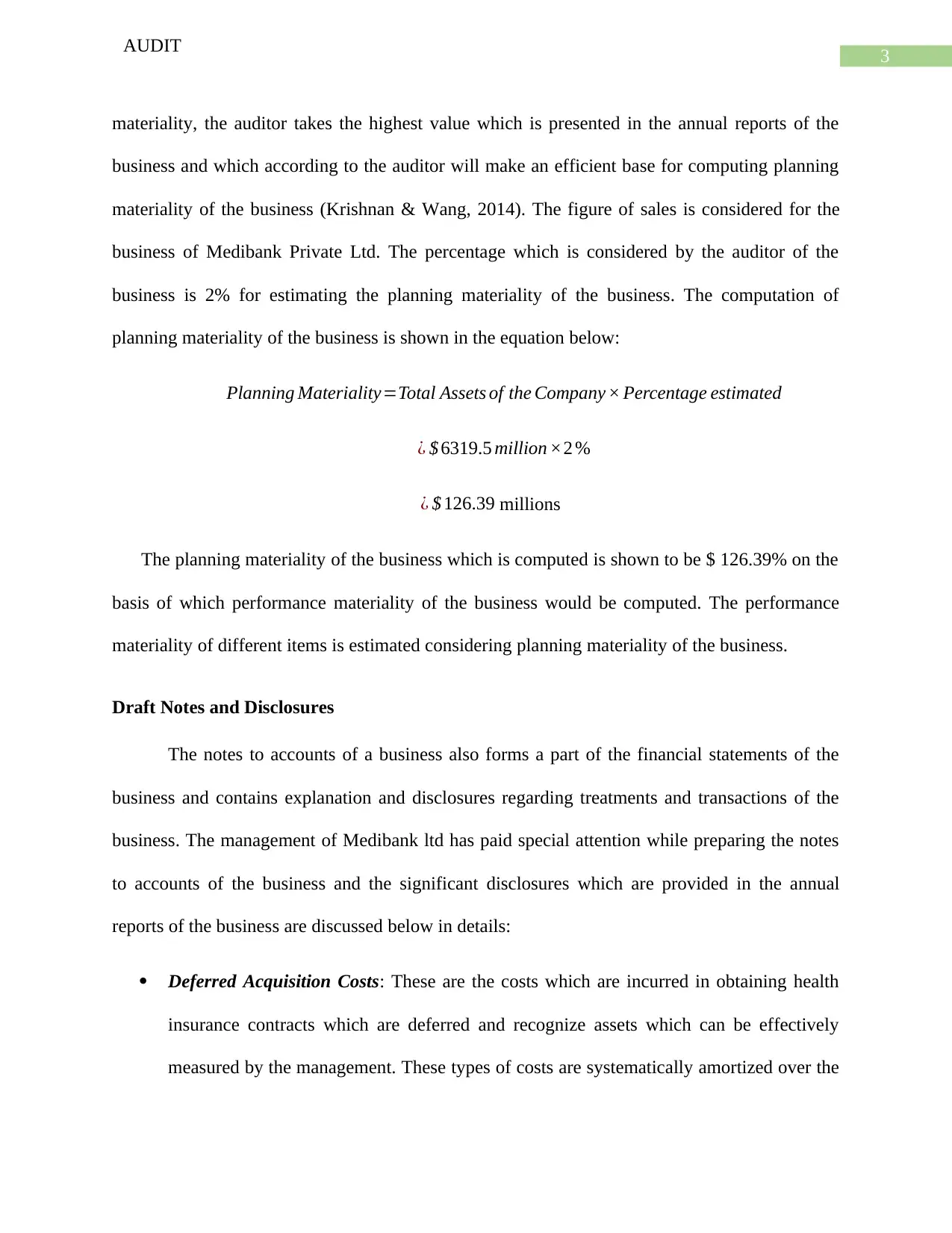
3
AUDIT
materiality, the auditor takes the highest value which is presented in the annual reports of the
business and which according to the auditor will make an efficient base for computing planning
materiality of the business (Krishnan & Wang, 2014). The figure of sales is considered for the
business of Medibank Private Ltd. The percentage which is considered by the auditor of the
business is 2% for estimating the planning materiality of the business. The computation of
planning materiality of the business is shown in the equation below:
Planning Materiality=Total Assets of the Company × Percentage estimated
¿ $ 6319.5 million ×2 %
¿ $ 126.39 millions
The planning materiality of the business which is computed is shown to be $ 126.39% on the
basis of which performance materiality of the business would be computed. The performance
materiality of different items is estimated considering planning materiality of the business.
Draft Notes and Disclosures
The notes to accounts of a business also forms a part of the financial statements of the
business and contains explanation and disclosures regarding treatments and transactions of the
business. The management of Medibank ltd has paid special attention while preparing the notes
to accounts of the business and the significant disclosures which are provided in the annual
reports of the business are discussed below in details:
Deferred Acquisition Costs: These are the costs which are incurred in obtaining health
insurance contracts which are deferred and recognize assets which can be effectively
measured by the management. These types of costs are systematically amortized over the
AUDIT
materiality, the auditor takes the highest value which is presented in the annual reports of the
business and which according to the auditor will make an efficient base for computing planning
materiality of the business (Krishnan & Wang, 2014). The figure of sales is considered for the
business of Medibank Private Ltd. The percentage which is considered by the auditor of the
business is 2% for estimating the planning materiality of the business. The computation of
planning materiality of the business is shown in the equation below:
Planning Materiality=Total Assets of the Company × Percentage estimated
¿ $ 6319.5 million ×2 %
¿ $ 126.39 millions
The planning materiality of the business which is computed is shown to be $ 126.39% on the
basis of which performance materiality of the business would be computed. The performance
materiality of different items is estimated considering planning materiality of the business.
Draft Notes and Disclosures
The notes to accounts of a business also forms a part of the financial statements of the
business and contains explanation and disclosures regarding treatments and transactions of the
business. The management of Medibank ltd has paid special attention while preparing the notes
to accounts of the business and the significant disclosures which are provided in the annual
reports of the business are discussed below in details:
Deferred Acquisition Costs: These are the costs which are incurred in obtaining health
insurance contracts which are deferred and recognize assets which can be effectively
measured by the management. These types of costs are systematically amortized over the
Paraphrase This Document
Need a fresh take? Get an instant paraphrase of this document with our AI Paraphraser
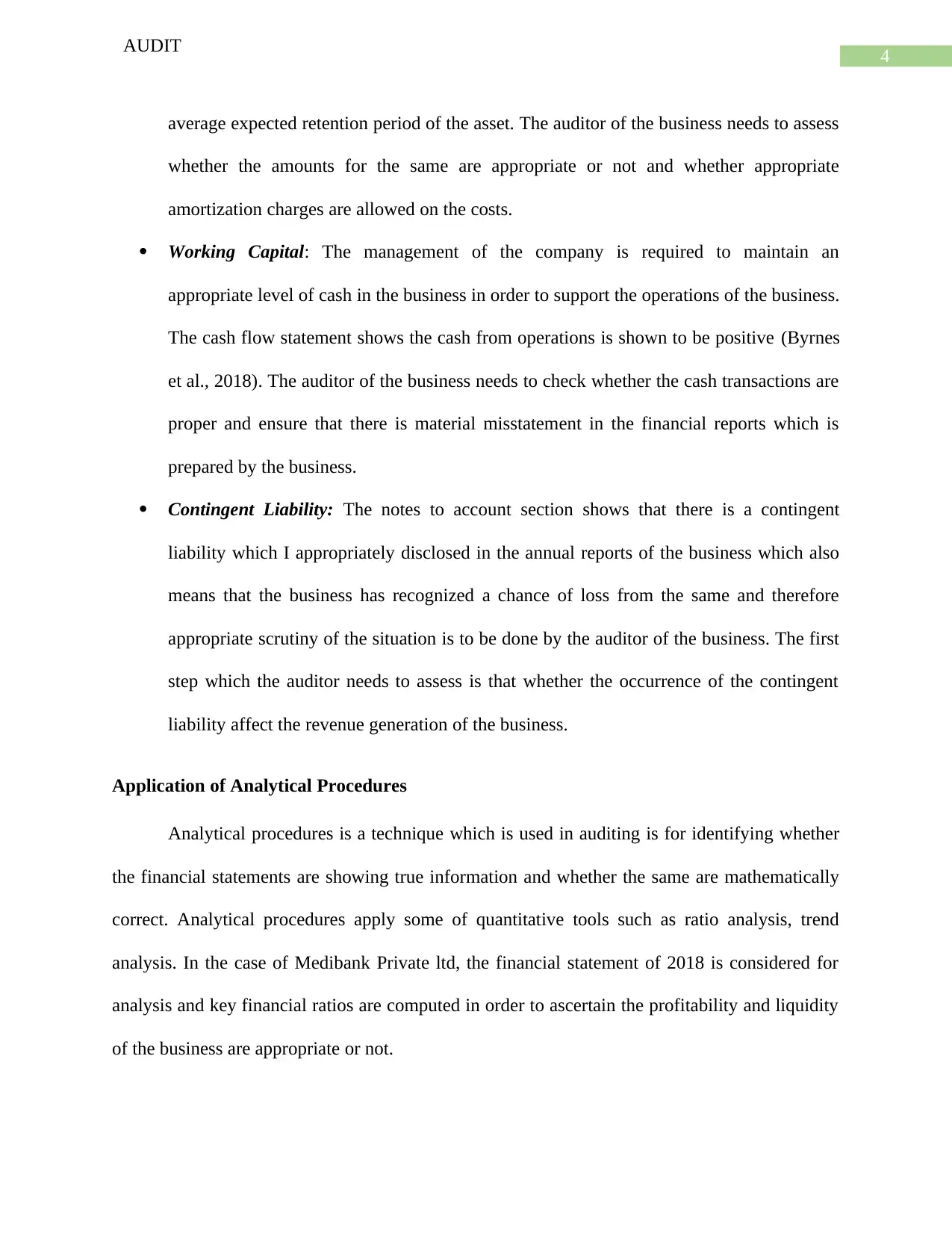
4
AUDIT
average expected retention period of the asset. The auditor of the business needs to assess
whether the amounts for the same are appropriate or not and whether appropriate
amortization charges are allowed on the costs.
Working Capital: The management of the company is required to maintain an
appropriate level of cash in the business in order to support the operations of the business.
The cash flow statement shows the cash from operations is shown to be positive (Byrnes
et al., 2018). The auditor of the business needs to check whether the cash transactions are
proper and ensure that there is material misstatement in the financial reports which is
prepared by the business.
Contingent Liability: The notes to account section shows that there is a contingent
liability which I appropriately disclosed in the annual reports of the business which also
means that the business has recognized a chance of loss from the same and therefore
appropriate scrutiny of the situation is to be done by the auditor of the business. The first
step which the auditor needs to assess is that whether the occurrence of the contingent
liability affect the revenue generation of the business.
Application of Analytical Procedures
Analytical procedures is a technique which is used in auditing is for identifying whether
the financial statements are showing true information and whether the same are mathematically
correct. Analytical procedures apply some of quantitative tools such as ratio analysis, trend
analysis. In the case of Medibank Private ltd, the financial statement of 2018 is considered for
analysis and key financial ratios are computed in order to ascertain the profitability and liquidity
of the business are appropriate or not.
AUDIT
average expected retention period of the asset. The auditor of the business needs to assess
whether the amounts for the same are appropriate or not and whether appropriate
amortization charges are allowed on the costs.
Working Capital: The management of the company is required to maintain an
appropriate level of cash in the business in order to support the operations of the business.
The cash flow statement shows the cash from operations is shown to be positive (Byrnes
et al., 2018). The auditor of the business needs to check whether the cash transactions are
proper and ensure that there is material misstatement in the financial reports which is
prepared by the business.
Contingent Liability: The notes to account section shows that there is a contingent
liability which I appropriately disclosed in the annual reports of the business which also
means that the business has recognized a chance of loss from the same and therefore
appropriate scrutiny of the situation is to be done by the auditor of the business. The first
step which the auditor needs to assess is that whether the occurrence of the contingent
liability affect the revenue generation of the business.
Application of Analytical Procedures
Analytical procedures is a technique which is used in auditing is for identifying whether
the financial statements are showing true information and whether the same are mathematically
correct. Analytical procedures apply some of quantitative tools such as ratio analysis, trend
analysis. In the case of Medibank Private ltd, the financial statement of 2018 is considered for
analysis and key financial ratios are computed in order to ascertain the profitability and liquidity
of the business are appropriate or not.
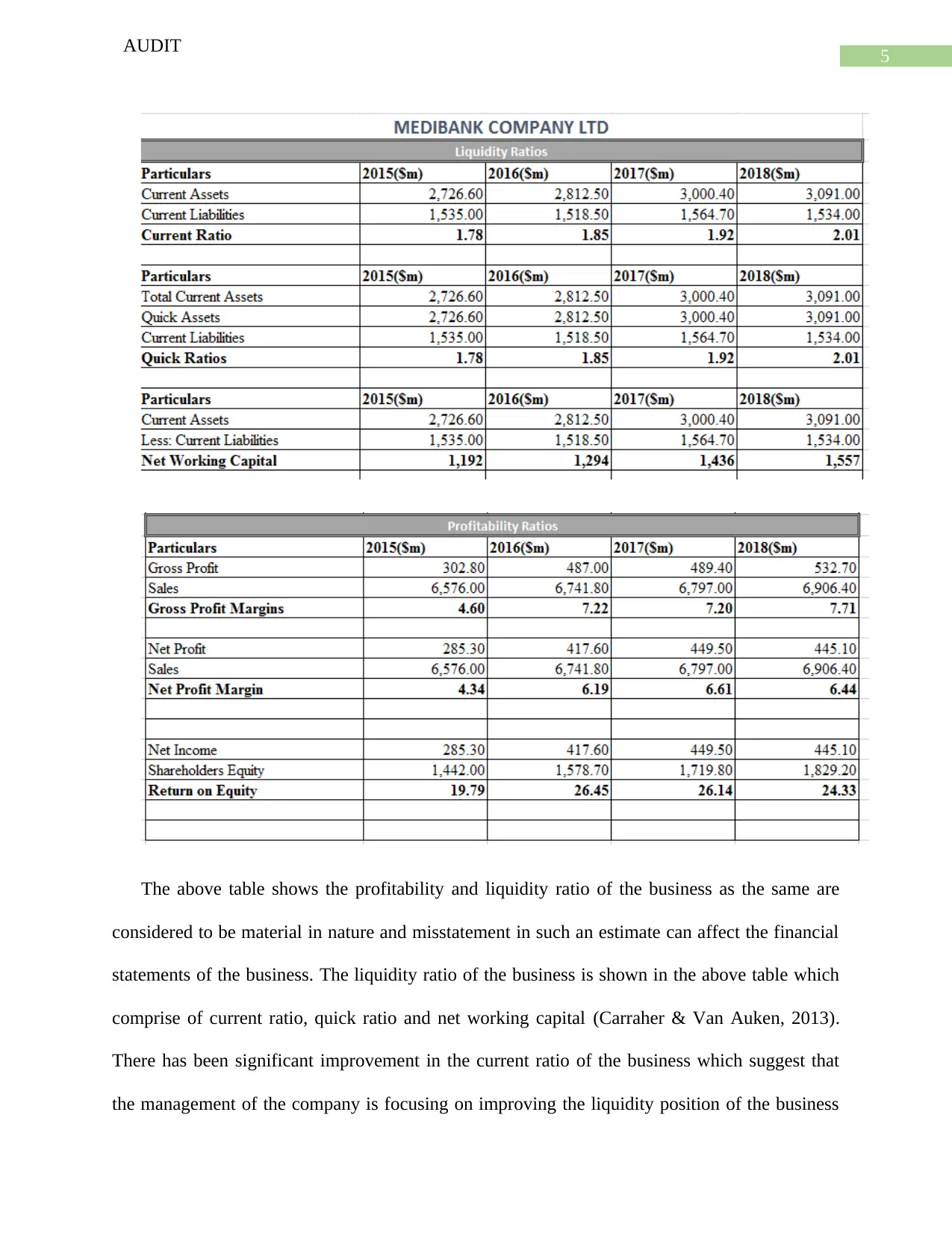
5
AUDIT
The above table shows the profitability and liquidity ratio of the business as the same are
considered to be material in nature and misstatement in such an estimate can affect the financial
statements of the business. The liquidity ratio of the business is shown in the above table which
comprise of current ratio, quick ratio and net working capital (Carraher & Van Auken, 2013).
There has been significant improvement in the current ratio of the business which suggest that
the management of the company is focusing on improving the liquidity position of the business
AUDIT
The above table shows the profitability and liquidity ratio of the business as the same are
considered to be material in nature and misstatement in such an estimate can affect the financial
statements of the business. The liquidity ratio of the business is shown in the above table which
comprise of current ratio, quick ratio and net working capital (Carraher & Van Auken, 2013).
There has been significant improvement in the current ratio of the business which suggest that
the management of the company is focusing on improving the liquidity position of the business
⊘ This is a preview!⊘
Do you want full access?
Subscribe today to unlock all pages.

Trusted by 1+ million students worldwide
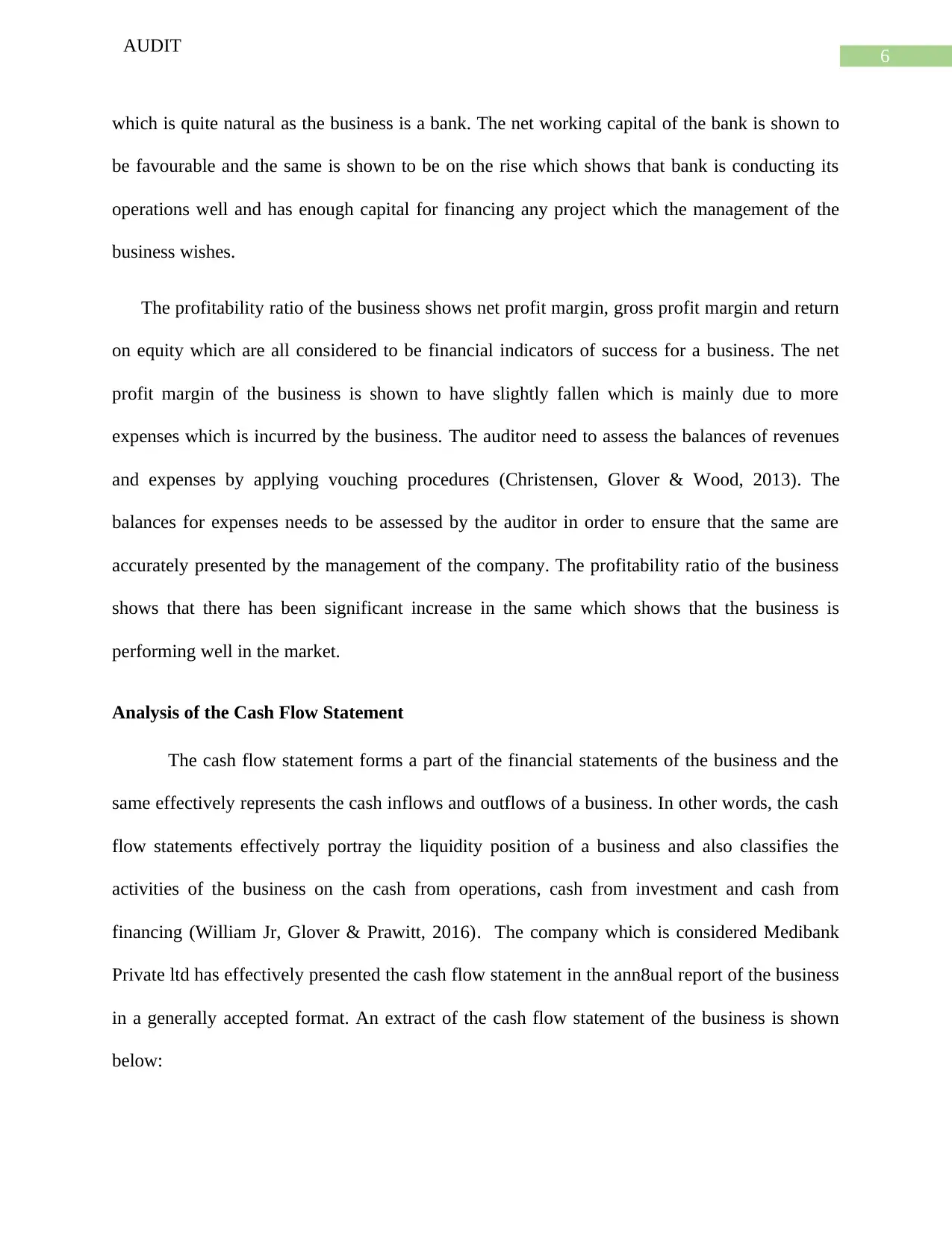
6
AUDIT
which is quite natural as the business is a bank. The net working capital of the bank is shown to
be favourable and the same is shown to be on the rise which shows that bank is conducting its
operations well and has enough capital for financing any project which the management of the
business wishes.
The profitability ratio of the business shows net profit margin, gross profit margin and return
on equity which are all considered to be financial indicators of success for a business. The net
profit margin of the business is shown to have slightly fallen which is mainly due to more
expenses which is incurred by the business. The auditor need to assess the balances of revenues
and expenses by applying vouching procedures (Christensen, Glover & Wood, 2013). The
balances for expenses needs to be assessed by the auditor in order to ensure that the same are
accurately presented by the management of the company. The profitability ratio of the business
shows that there has been significant increase in the same which shows that the business is
performing well in the market.
Analysis of the Cash Flow Statement
The cash flow statement forms a part of the financial statements of the business and the
same effectively represents the cash inflows and outflows of a business. In other words, the cash
flow statements effectively portray the liquidity position of a business and also classifies the
activities of the business on the cash from operations, cash from investment and cash from
financing (William Jr, Glover & Prawitt, 2016). The company which is considered Medibank
Private ltd has effectively presented the cash flow statement in the ann8ual report of the business
in a generally accepted format. An extract of the cash flow statement of the business is shown
below:
AUDIT
which is quite natural as the business is a bank. The net working capital of the bank is shown to
be favourable and the same is shown to be on the rise which shows that bank is conducting its
operations well and has enough capital for financing any project which the management of the
business wishes.
The profitability ratio of the business shows net profit margin, gross profit margin and return
on equity which are all considered to be financial indicators of success for a business. The net
profit margin of the business is shown to have slightly fallen which is mainly due to more
expenses which is incurred by the business. The auditor need to assess the balances of revenues
and expenses by applying vouching procedures (Christensen, Glover & Wood, 2013). The
balances for expenses needs to be assessed by the auditor in order to ensure that the same are
accurately presented by the management of the company. The profitability ratio of the business
shows that there has been significant increase in the same which shows that the business is
performing well in the market.
Analysis of the Cash Flow Statement
The cash flow statement forms a part of the financial statements of the business and the
same effectively represents the cash inflows and outflows of a business. In other words, the cash
flow statements effectively portray the liquidity position of a business and also classifies the
activities of the business on the cash from operations, cash from investment and cash from
financing (William Jr, Glover & Prawitt, 2016). The company which is considered Medibank
Private ltd has effectively presented the cash flow statement in the ann8ual report of the business
in a generally accepted format. An extract of the cash flow statement of the business is shown
below:
Paraphrase This Document
Need a fresh take? Get an instant paraphrase of this document with our AI Paraphraser
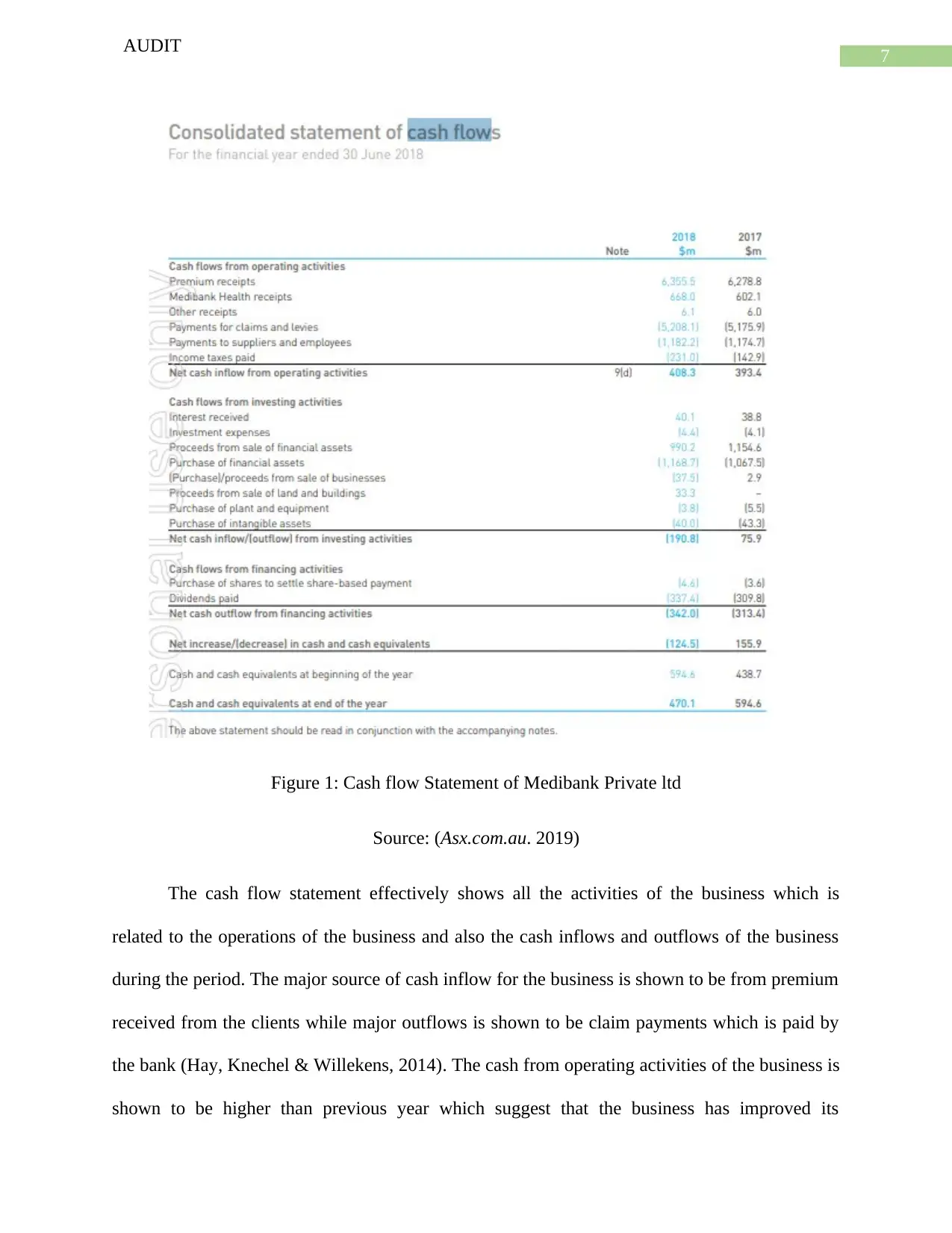
7
AUDIT
Figure 1: Cash flow Statement of Medibank Private ltd
Source: (Asx.com.au. 2019)
The cash flow statement effectively shows all the activities of the business which is
related to the operations of the business and also the cash inflows and outflows of the business
during the period. The major source of cash inflow for the business is shown to be from premium
received from the clients while major outflows is shown to be claim payments which is paid by
the bank (Hay, Knechel & Willekens, 2014). The cash from operating activities of the business is
shown to be higher than previous year which suggest that the business has improved its
AUDIT
Figure 1: Cash flow Statement of Medibank Private ltd
Source: (Asx.com.au. 2019)
The cash flow statement effectively shows all the activities of the business which is
related to the operations of the business and also the cash inflows and outflows of the business
during the period. The major source of cash inflow for the business is shown to be from premium
received from the clients while major outflows is shown to be claim payments which is paid by
the bank (Hay, Knechel & Willekens, 2014). The cash from operating activities of the business is
shown to be higher than previous year which suggest that the business has improved its
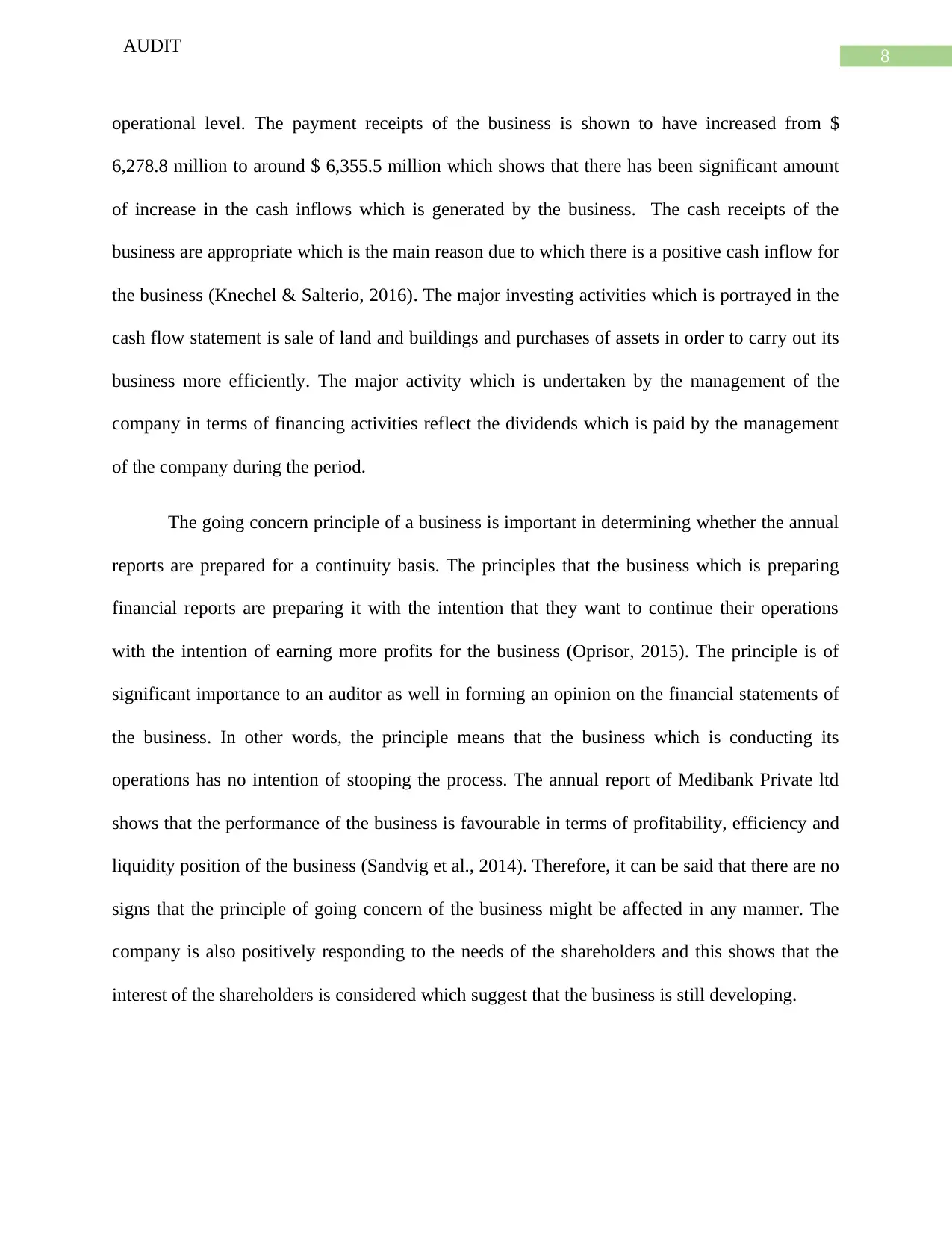
8
AUDIT
operational level. The payment receipts of the business is shown to have increased from $
6,278.8 million to around $ 6,355.5 million which shows that there has been significant amount
of increase in the cash inflows which is generated by the business. The cash receipts of the
business are appropriate which is the main reason due to which there is a positive cash inflow for
the business (Knechel & Salterio, 2016). The major investing activities which is portrayed in the
cash flow statement is sale of land and buildings and purchases of assets in order to carry out its
business more efficiently. The major activity which is undertaken by the management of the
company in terms of financing activities reflect the dividends which is paid by the management
of the company during the period.
The going concern principle of a business is important in determining whether the annual
reports are prepared for a continuity basis. The principles that the business which is preparing
financial reports are preparing it with the intention that they want to continue their operations
with the intention of earning more profits for the business (Oprisor, 2015). The principle is of
significant importance to an auditor as well in forming an opinion on the financial statements of
the business. In other words, the principle means that the business which is conducting its
operations has no intention of stooping the process. The annual report of Medibank Private ltd
shows that the performance of the business is favourable in terms of profitability, efficiency and
liquidity position of the business (Sandvig et al., 2014). Therefore, it can be said that there are no
signs that the principle of going concern of the business might be affected in any manner. The
company is also positively responding to the needs of the shareholders and this shows that the
interest of the shareholders is considered which suggest that the business is still developing.
AUDIT
operational level. The payment receipts of the business is shown to have increased from $
6,278.8 million to around $ 6,355.5 million which shows that there has been significant amount
of increase in the cash inflows which is generated by the business. The cash receipts of the
business are appropriate which is the main reason due to which there is a positive cash inflow for
the business (Knechel & Salterio, 2016). The major investing activities which is portrayed in the
cash flow statement is sale of land and buildings and purchases of assets in order to carry out its
business more efficiently. The major activity which is undertaken by the management of the
company in terms of financing activities reflect the dividends which is paid by the management
of the company during the period.
The going concern principle of a business is important in determining whether the annual
reports are prepared for a continuity basis. The principles that the business which is preparing
financial reports are preparing it with the intention that they want to continue their operations
with the intention of earning more profits for the business (Oprisor, 2015). The principle is of
significant importance to an auditor as well in forming an opinion on the financial statements of
the business. In other words, the principle means that the business which is conducting its
operations has no intention of stooping the process. The annual report of Medibank Private ltd
shows that the performance of the business is favourable in terms of profitability, efficiency and
liquidity position of the business (Sandvig et al., 2014). Therefore, it can be said that there are no
signs that the principle of going concern of the business might be affected in any manner. The
company is also positively responding to the needs of the shareholders and this shows that the
interest of the shareholders is considered which suggest that the business is still developing.
⊘ This is a preview!⊘
Do you want full access?
Subscribe today to unlock all pages.

Trusted by 1+ million students worldwide
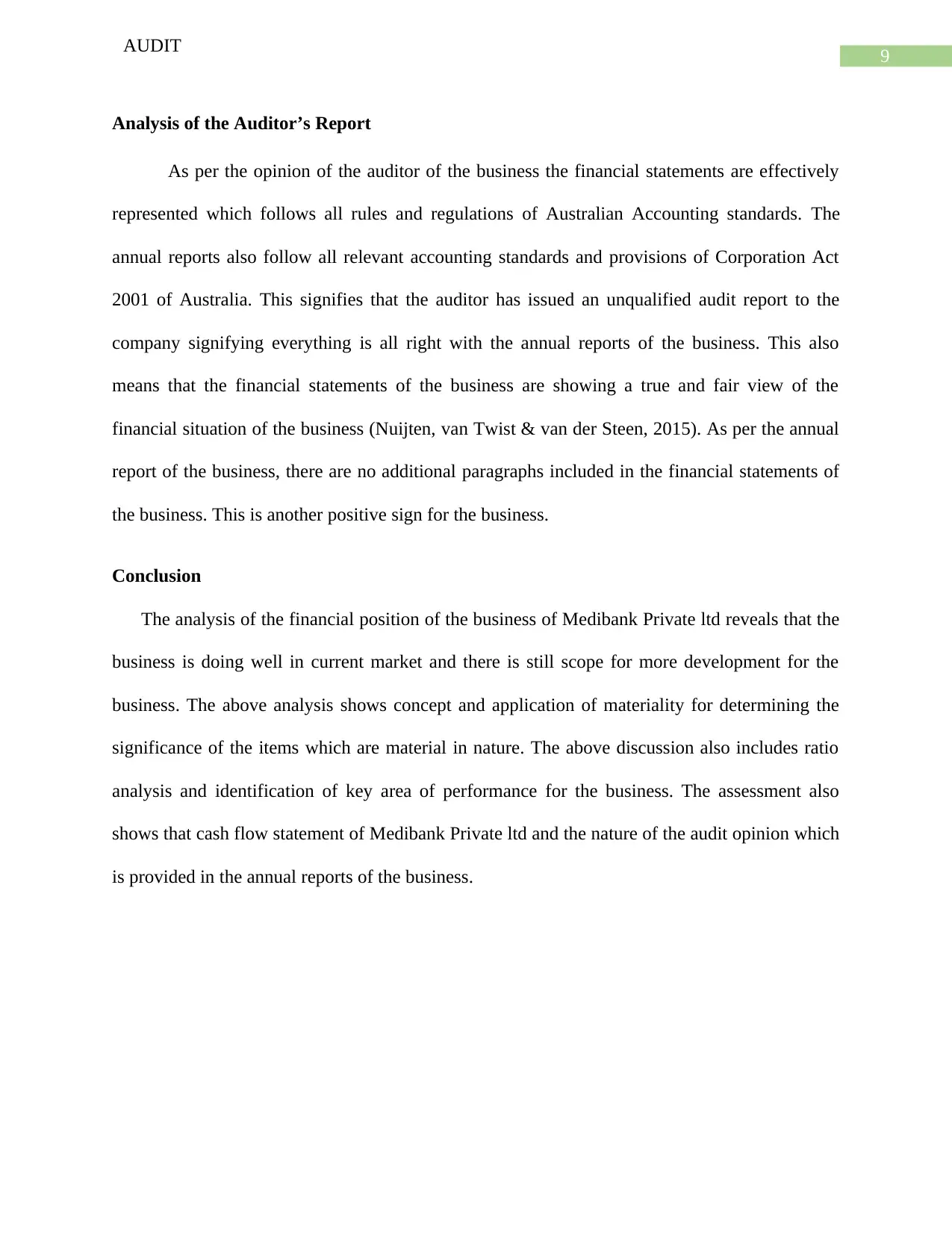
9
AUDIT
Analysis of the Auditor’s Report
As per the opinion of the auditor of the business the financial statements are effectively
represented which follows all rules and regulations of Australian Accounting standards. The
annual reports also follow all relevant accounting standards and provisions of Corporation Act
2001 of Australia. This signifies that the auditor has issued an unqualified audit report to the
company signifying everything is all right with the annual reports of the business. This also
means that the financial statements of the business are showing a true and fair view of the
financial situation of the business (Nuijten, van Twist & van der Steen, 2015). As per the annual
report of the business, there are no additional paragraphs included in the financial statements of
the business. This is another positive sign for the business.
Conclusion
The analysis of the financial position of the business of Medibank Private ltd reveals that the
business is doing well in current market and there is still scope for more development for the
business. The above analysis shows concept and application of materiality for determining the
significance of the items which are material in nature. The above discussion also includes ratio
analysis and identification of key area of performance for the business. The assessment also
shows that cash flow statement of Medibank Private ltd and the nature of the audit opinion which
is provided in the annual reports of the business.
AUDIT
Analysis of the Auditor’s Report
As per the opinion of the auditor of the business the financial statements are effectively
represented which follows all rules and regulations of Australian Accounting standards. The
annual reports also follow all relevant accounting standards and provisions of Corporation Act
2001 of Australia. This signifies that the auditor has issued an unqualified audit report to the
company signifying everything is all right with the annual reports of the business. This also
means that the financial statements of the business are showing a true and fair view of the
financial situation of the business (Nuijten, van Twist & van der Steen, 2015). As per the annual
report of the business, there are no additional paragraphs included in the financial statements of
the business. This is another positive sign for the business.
Conclusion
The analysis of the financial position of the business of Medibank Private ltd reveals that the
business is doing well in current market and there is still scope for more development for the
business. The above analysis shows concept and application of materiality for determining the
significance of the items which are material in nature. The above discussion also includes ratio
analysis and identification of key area of performance for the business. The assessment also
shows that cash flow statement of Medibank Private ltd and the nature of the audit opinion which
is provided in the annual reports of the business.
Paraphrase This Document
Need a fresh take? Get an instant paraphrase of this document with our AI Paraphraser
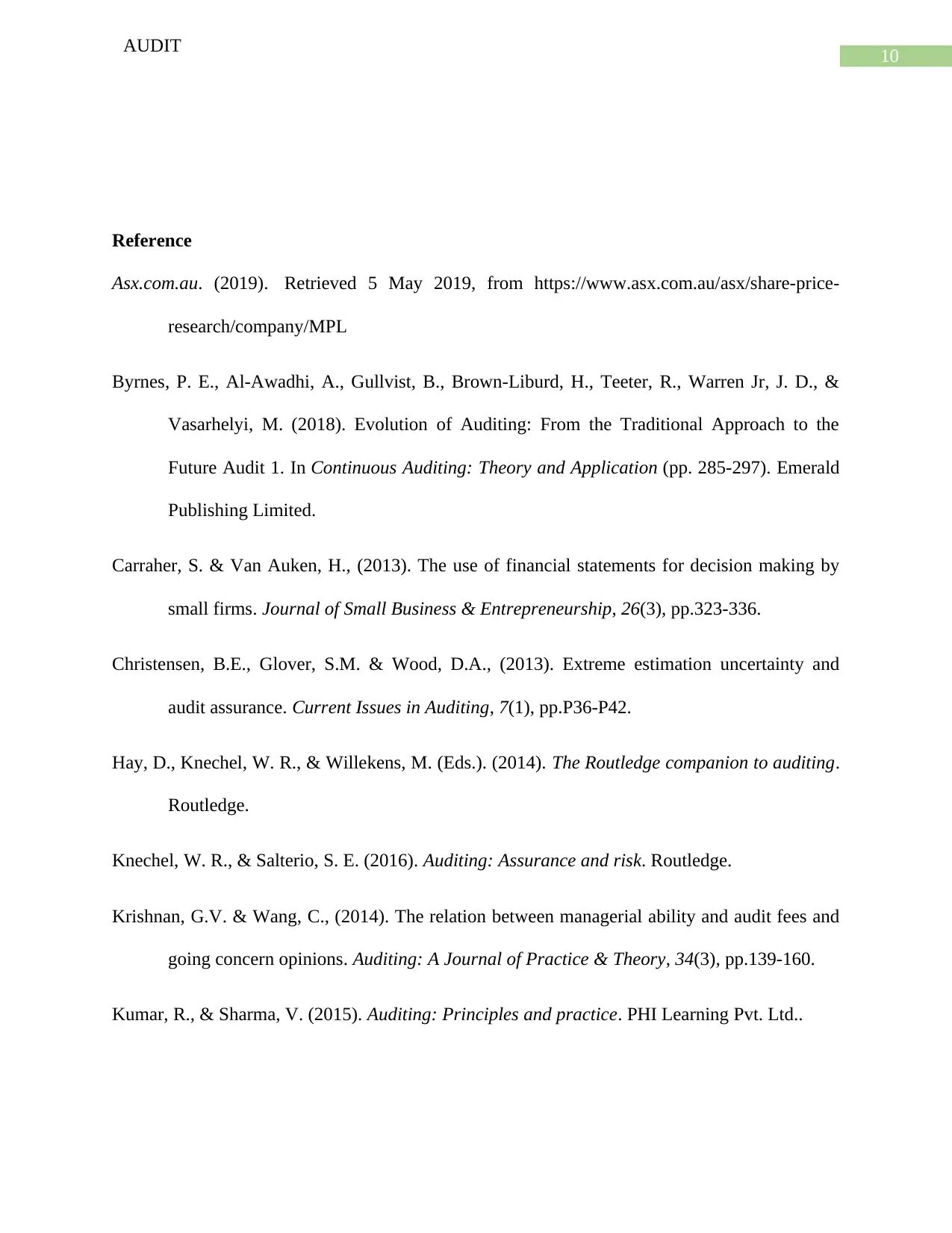
10
AUDIT
Reference
Asx.com.au. (2019). Retrieved 5 May 2019, from https://www.asx.com.au/asx/share-price-
research/company/MPL
Byrnes, P. E., Al-Awadhi, A., Gullvist, B., Brown-Liburd, H., Teeter, R., Warren Jr, J. D., &
Vasarhelyi, M. (2018). Evolution of Auditing: From the Traditional Approach to the
Future Audit 1. In Continuous Auditing: Theory and Application (pp. 285-297). Emerald
Publishing Limited.
Carraher, S. & Van Auken, H., (2013). The use of financial statements for decision making by
small firms. Journal of Small Business & Entrepreneurship, 26(3), pp.323-336.
Christensen, B.E., Glover, S.M. & Wood, D.A., (2013). Extreme estimation uncertainty and
audit assurance. Current Issues in Auditing, 7(1), pp.P36-P42.
Hay, D., Knechel, W. R., & Willekens, M. (Eds.). (2014). The Routledge companion to auditing.
Routledge.
Knechel, W. R., & Salterio, S. E. (2016). Auditing: Assurance and risk. Routledge.
Krishnan, G.V. & Wang, C., (2014). The relation between managerial ability and audit fees and
going concern opinions. Auditing: A Journal of Practice & Theory, 34(3), pp.139-160.
Kumar, R., & Sharma, V. (2015). Auditing: Principles and practice. PHI Learning Pvt. Ltd..
AUDIT
Reference
Asx.com.au. (2019). Retrieved 5 May 2019, from https://www.asx.com.au/asx/share-price-
research/company/MPL
Byrnes, P. E., Al-Awadhi, A., Gullvist, B., Brown-Liburd, H., Teeter, R., Warren Jr, J. D., &
Vasarhelyi, M. (2018). Evolution of Auditing: From the Traditional Approach to the
Future Audit 1. In Continuous Auditing: Theory and Application (pp. 285-297). Emerald
Publishing Limited.
Carraher, S. & Van Auken, H., (2013). The use of financial statements for decision making by
small firms. Journal of Small Business & Entrepreneurship, 26(3), pp.323-336.
Christensen, B.E., Glover, S.M. & Wood, D.A., (2013). Extreme estimation uncertainty and
audit assurance. Current Issues in Auditing, 7(1), pp.P36-P42.
Hay, D., Knechel, W. R., & Willekens, M. (Eds.). (2014). The Routledge companion to auditing.
Routledge.
Knechel, W. R., & Salterio, S. E. (2016). Auditing: Assurance and risk. Routledge.
Krishnan, G.V. & Wang, C., (2014). The relation between managerial ability and audit fees and
going concern opinions. Auditing: A Journal of Practice & Theory, 34(3), pp.139-160.
Kumar, R., & Sharma, V. (2015). Auditing: Principles and practice. PHI Learning Pvt. Ltd..
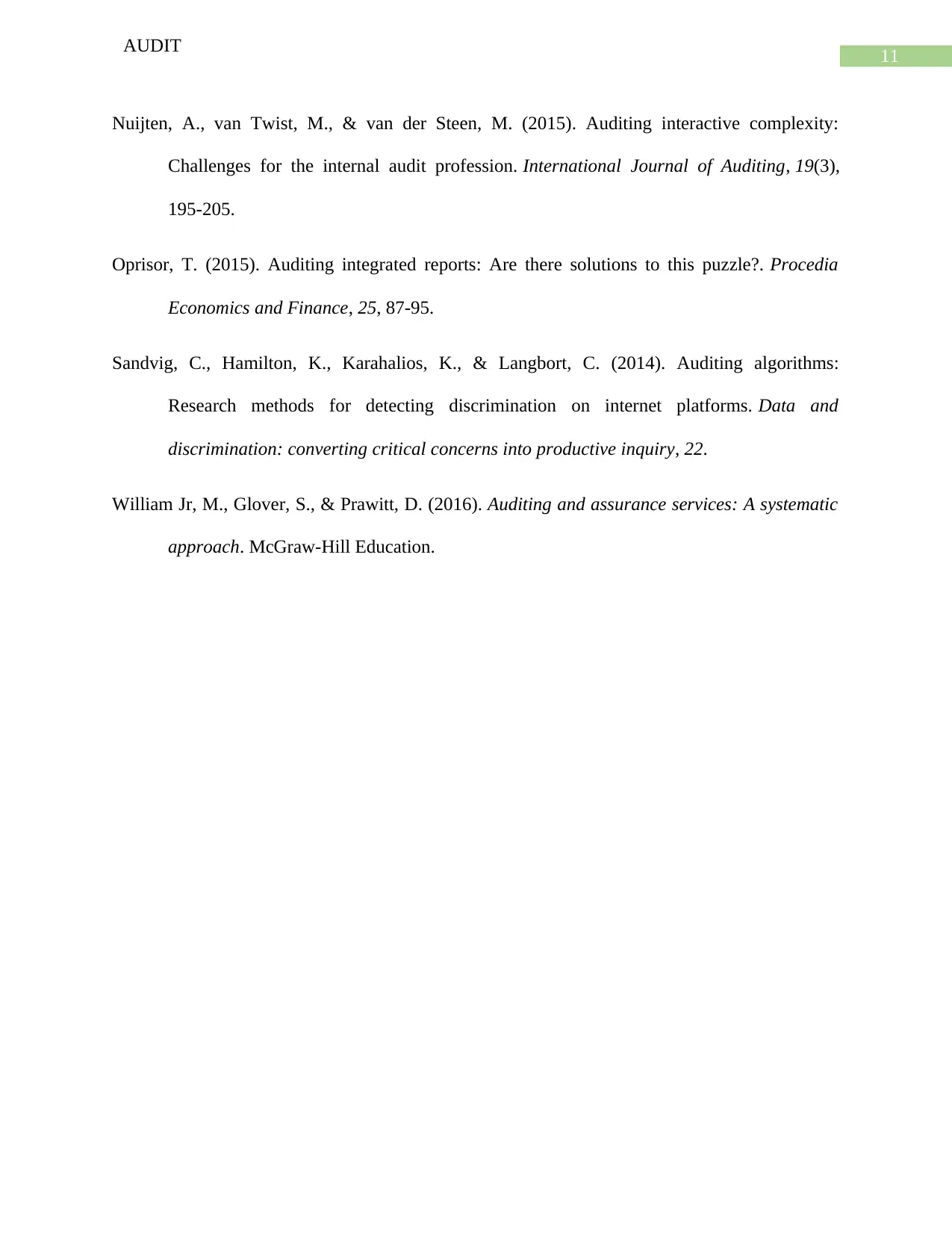
11
AUDIT
Nuijten, A., van Twist, M., & van der Steen, M. (2015). Auditing interactive complexity:
Challenges for the internal audit profession. International Journal of Auditing, 19(3),
195-205.
Oprisor, T. (2015). Auditing integrated reports: Are there solutions to this puzzle?. Procedia
Economics and Finance, 25, 87-95.
Sandvig, C., Hamilton, K., Karahalios, K., & Langbort, C. (2014). Auditing algorithms:
Research methods for detecting discrimination on internet platforms. Data and
discrimination: converting critical concerns into productive inquiry, 22.
William Jr, M., Glover, S., & Prawitt, D. (2016). Auditing and assurance services: A systematic
approach. McGraw-Hill Education.
AUDIT
Nuijten, A., van Twist, M., & van der Steen, M. (2015). Auditing interactive complexity:
Challenges for the internal audit profession. International Journal of Auditing, 19(3),
195-205.
Oprisor, T. (2015). Auditing integrated reports: Are there solutions to this puzzle?. Procedia
Economics and Finance, 25, 87-95.
Sandvig, C., Hamilton, K., Karahalios, K., & Langbort, C. (2014). Auditing algorithms:
Research methods for detecting discrimination on internet platforms. Data and
discrimination: converting critical concerns into productive inquiry, 22.
William Jr, M., Glover, S., & Prawitt, D. (2016). Auditing and assurance services: A systematic
approach. McGraw-Hill Education.
⊘ This is a preview!⊘
Do you want full access?
Subscribe today to unlock all pages.

Trusted by 1+ million students worldwide
1 out of 12
Related Documents
Your All-in-One AI-Powered Toolkit for Academic Success.
+13062052269
info@desklib.com
Available 24*7 on WhatsApp / Email
![[object Object]](/_next/static/media/star-bottom.7253800d.svg)
Unlock your academic potential
Copyright © 2020–2025 A2Z Services. All Rights Reserved. Developed and managed by ZUCOL.





